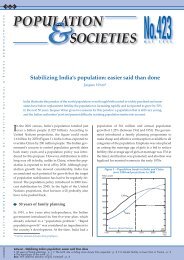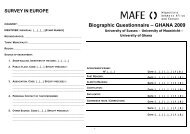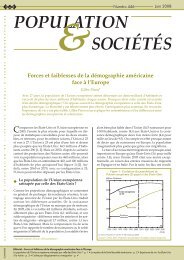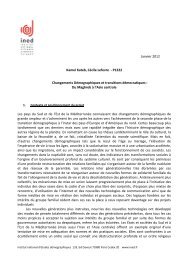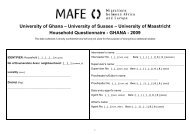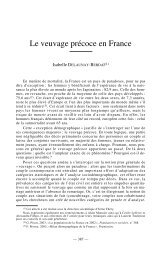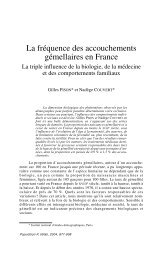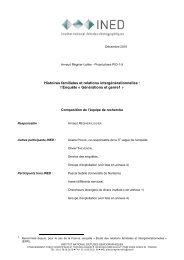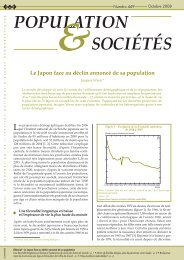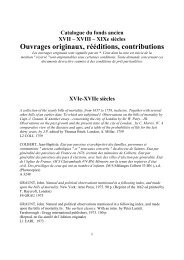Pratique de Sas Windows 9.2... Volume 1 - Ined
Pratique de Sas Windows 9.2... Volume 1 - Ined
Pratique de Sas Windows 9.2... Volume 1 - Ined
Create successful ePaper yourself
Turn your PDF publications into a flip-book with our unique Google optimized e-Paper software.
Et le classeur multifeuilles ?<br />
La macro <strong>de</strong> la page suivante, rédigée à l’origine par Paul Choate * et adaptée, vous permettra <strong>de</strong> récupérer<br />
sous formes <strong>de</strong> tables, TOUTES les feuilles d’un classeur, même si les noms <strong>de</strong> feuilles sont en double ou avec<br />
<strong>de</strong>s blancs ou commençant avec un nombre.<br />
%macro xlcopy(path=,file=,Hea<strong>de</strong>r=Yes,Mixed=No);<br />
/* libname accès à Excel avec piochage en première ligne et<br />
maintien du type num ou char*/<br />
libname excelbk excel "&path.&file." Hea<strong>de</strong>r=&Hea<strong>de</strong>r Mixed=&Mixed ;<br />
/* noms <strong>de</strong>s feuilles */<br />
proc sql noprint;<br />
select memname into :xl1 - :xl999<br />
from sashelp.vtable<br />
where upcase(libname) = upcase('excelbk') ;<br />
%let numds = &sqlobs;<br />
quit;<br />
/* transformées en noms autorisés <strong>de</strong> tables*/<br />
%MACRO dsnames;<br />
data file;<br />
length file $32;<br />
%DO I=1 %TO &numds;<br />
file=compress("&&xl&i",' ','NK');<br />
if anyfirst(file)>1 then substr(file,1,1)='_';<br />
dsvar="ds&i";<br />
output;<br />
%END;<br />
run;<br />
%MEND dsnames;<br />
%dsnames<br />
proc sort data=file;<br />
by file dsvar;<br />
run;<br />
/* si noms en doublons, renommer */<br />
data _null_;<br />
set file;<br />
by file dsvar;<br />
if first.file then n=0;<br />
if not first.file then do;<br />
n+1;<br />
file=trim(file)||'_'||put(n,z2.);<br />
end;<br />
call symput(dsvar,trim(file));<br />
run;<br />
proc <strong>de</strong>lete data=file;run;<br />
/* Copies <strong>de</strong>s feuilles */<br />
%MACRO copyfl;<br />
%DO I=1 %TO &numds;<br />
proc sql noprint;<br />
create table "&&ds&i"n as select *<br />
from excelbk."&&xl&i"n;<br />
quit;<br />
%END;<br />
%MEND copyfl;<br />
%copyfl<br />
libname excelbk clear;<br />
%mend xlcopy;<br />
%xlcopy(path=d:\sasv913\,file=libexcel.xls,Hea<strong>de</strong>r=Yes,Mixed=No);<br />
*Auteur également <strong>de</strong> ce texte pour la 9.1.3 ( !) avec Carol Martell<br />
http://www2.sas.com/proceedings/sugi31/024-31.pdf<br />
« DeMystifying the SAS® LIBNAME Engine in Microsoft Excel: A Practical Gui<strong>de</strong> »<br />
Je rajoute ici, à posteriori, un papier tout récent sur le libname:<br />
« The Little Engine That Could: Using EXCEL LIBNAME Engine Options to Enhance Data Transfers<br />
between SAS® and Microsoft® Excel Files » <strong>de</strong> William E Benjamin Jr<br />
http://www.lexjansen.com/pharmasug/2010/ad/ad10.pdf<br />
INED Wielki 107





